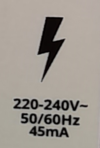Indeed I am (give or take the complication I mentioned in relation to halogens), since I wrote:Obviously you are well aware that voltage rating of lamps is quite critical to an incandescent lamps longevity?
You go on to say ........ it is inevitable that, no matter what voltage they are designed for, any traditional incandescent bulb (and quite probably many LEDs) will have a longer life at 216.2V than at 130V, and a longer life with 230V than with 253V. Halogens are a bit more complicated, in that reducing voltage reduces the envelope temperature and hence may, in some situations, decrease life.
... and, equally, a "250V lamp" or a "260V lamp" would have a markedly shorter life if supplied with 240V than if it were supplied with 230V, and a much shorter life than if it were supplied with 216.2V (previously mentioned possible caveats about halogens accepted).A 230v lamp, on an actual 240v supply will have a severally reduced working life.
You still haven't really answered my question as to what you mean by "a 230V lamp". Given the wide variation (around the nominal voltage) that exists in any country, I'm not sure what you are suggesting. There will always be considerable variation in life expectancy of bulbs across the range of permitted supply voltages, so there's not much a manufacturer can do other than manufacture bulbs to have a certain (average) life at the nominal voltage (and quote the 'average life expectancy' at that nominal voltage).Yet some sellers seem to not be aware, or care about this and sell 230v lamps intended for use in the EU.
As I understand it, the nominal voltage in both UK and EU is 230V, the only difference being (to 'correspond with reality/history'!) that the asymmetrical permitted limits are asymmetrical in opposite directions in UK and EU - 230V -6% +10% in UK (216.2V - 253V) and 23)V -10% + 6% in EU (207V - 243.8V).
It is, of course (for reasons of history and reality!) the case that voltages in EU will tend to be appreciably lower in the EU than in the UK which means that the life expectancy of ANY bulb is going to be, on average, longer in the EU - but that may well almost fades into insignificance in comparison with the nearly 40V wide 'permitted range of variation in both UK and EU.
Kind Regards, John


